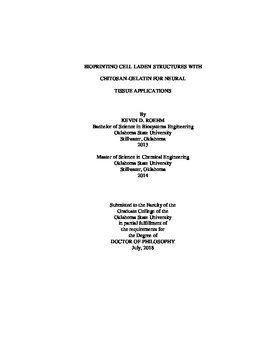| dc.description.abstract | Nearly 1 billion people suffer from neurological disorders, and approximately 400,000 patients require surgical intervention to repair damaged peripheral nerves every year. There is a need, therefore, for three-dimensional synthetic tissues to serve as both models and regenerative structures. Primary human neural cells are not directly obtainable. Differentiated, patient specific adult adipocyte stem cells would offer a non-immunogenic, abundant source of cells for regenerative implant applications and in vitro models. However, mature, differentiated cells are difficult to obtain reproducibly. Bioprinting is an attractive approach to building 3D tissues. However, bioinks that transform into stable solids in physiologically conducive environments are needed. Also, cell survival post-printing is an issue, and printing processes effect on cell responses need to be investigated. I developed a preparation process that allows for continuous, consistent printing of a chitosan-gelatin (CG) hydrogel that does not require post-processing. I investigated the effect of print bed temperature, feed rate, flow rate, and needle height on fiber sizes. Further, I designed and developed a compact electrical stimulation device to investigate cell response post-printing. I used computer modeling to ensure I obtained a constant electrical field, similar to traditional devices. Using the developed device, I investigated the response and expression of B-III-tubulin of human neuroblasts (NBs) and human adipocyte stem cells (hASCs) to electrical stimulation and to the bioprinting process, separately and in combination. The CG hydrogel was successfully bioprinted: the bed temperature had the greatest effect on fiber size (resolution), followed by feed rate and cells were well distributed when printed, maintained viability, and no contamination was observed after 5 days. A compact device was designed with a constant electric field that could be maintained sterile during microscopic observation for 6 days post-stimulation. Both NBs and hASCs showed differentiation towards a neural lineage when electrically stimulated. NBs were more sensitive to the printing process than hASCs losing actin polymerization when printed through a 34g needle. Finally, hASCs exhibit significant B-III-tubulin and neuron-like cell morphology 6-days after printing through a 34g needle. | |
